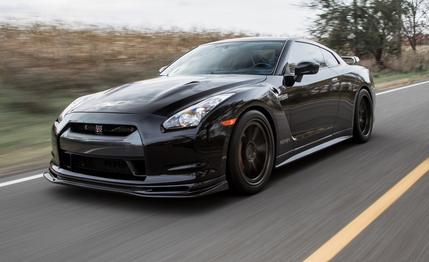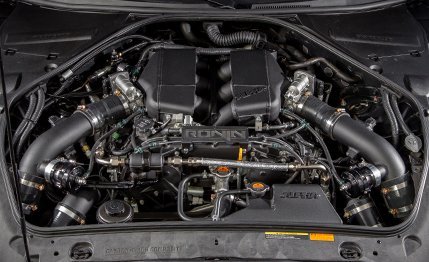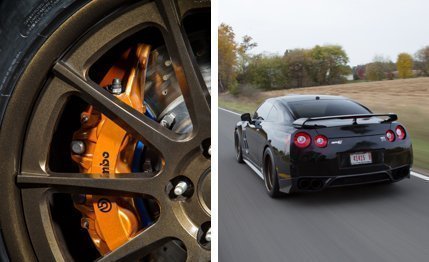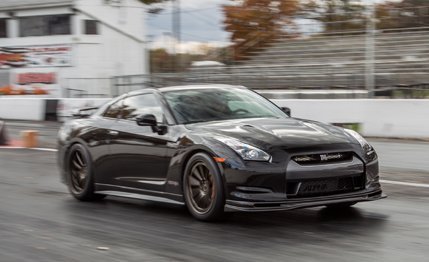
 Instrumented Test
Instrumented Test
Meet the 1000-hp Nissan GT-R called the “Ronin.” The name, which translates roughly as “a warrior without a master,” would seem to overdo it on the samurai imagery, but this car, this barn-built Bugatti, is the quickest road car we’ve tested in our 59 years. So maybe the name fits.
AMS Performance in West Chicago, Illinois, built the Ronin, which is not even the quickest GT-R it sells. That one has 1800 horsepower and a service interval of a quarter-mile. AMS president Martin Musial explained, however, that the Ronin is its optimal street-going package.
To achieve the four-figure horsepower rating and 850 pound-feet of torque, all on 93 octane, AMS installs a stroker crank and connecting rods in the GT-R’s stock V-6 block, increasing displacement from 3.8 liters to 4.2. Dished pistons drop the compression ratio to 9.5:1, and the factory turbos are gutted and rebuilt with custom compressors and Garrett GT35 turbine wheels, yielding a maximum of 21.0 psi of boost. The tuner upgrades the intercooler, fuel system, and blow-off valves, and tucks new intakes in the bumper. Despite the increase in stroke, AMS raises the engine redline from 8000 rpm to a Wankel-like 9000. The Ronin package starts at $60,000, plus the cost of a GT-R.

 Why yes, those are robot arms under the Ronin's hood. How else do you think the Nissan V-6 makes such insane power?
Why yes, those are robot arms under the Ronin's hood. How else do you think the Nissan V-6 makes such insane power?
Godzilla transmissions were notoriously fragile in the R35’s first few years of production. To help the trans withstand the extra torque, AMS replaces first and second gears with stouter—and even noisier—cogs, and installs new half-shafts designed to take the extra twist. Our black tester came with a $7145 carbon-fiber appearance package that includes a woven roof panel and other exterior carbon-fiber–clad trim.
Like many tuned cars, the Ronin is essentially a prototype and is thus subject to mechanical failures not commonly experienced in production machines. During our first testing attempt, the right-rear half-shaft snapped at the hub. The second attempt revealed that the shaft shearing caused the transmission to divert too much torque through the front driveshaft, with the surge of torque frying the front-driveshaft clutch. The car succeeded on our third testing attempt, but this time there was a human failure: We neglected to press the record button on our test gear. It wasn’t until our fourth attempt that we had results in hand.
While a sub-three-second zero-to-60-mph time is attainable by some production cars such as the Bugatti Veyron and the Porsche 911 Turbo S, this monsterfied Nissan ran to 100 in 5.1 seconds and 150 in just 10.1, acceleration unprecedented in our testing experience. Seeing as the car broke on the first test, and we had good runs in the bag, we thought it prudent to test the car’s durability. The Ronin not only withstood 17 flat-out launches, its last run was just as quick as the first, revealing that the rest of the car is quite solid.

 Left: The Ronin wore $8220 in wheels and tires, because reversing the Earth's rotation requires getting the power down.
Left: The Ronin wore $8220 in wheels and tires, because reversing the Earth's rotation requires getting the power down.
Anxiety builds in lock step with revs as we engage launch control at 4200 rpm. A quarter-mile flashes by in 10 seconds, barely enough time to take a breath, at which point the Ronin is traveling at 149 mph. Lifting off the throttle and coasting down after such a short trip to 150 mph gives your body time to absorb the endorphins. It’s a rush that recalibrates your sense of acceleration, making everything else feel slow.
Wisely, AMS doesn’t mess with the GT-R’s suspension for its “street” customers. It does, however, install new three-piece wheels and non-run-flat Michelin Pilot Super Sport tires for an additional $8220, which marginally improve a stock GT-R’s near-rigid suspension tune.
A snowy tarmac prevented us from finding out if the wider rubber—285s in front and 335s in back—benefits grip, though we can say that turn-in quality is just as immediate as in a stock GT-R.


Taming the power for daily driving isn’t nearly as easy as engaging launch control. The difference between neighborhood-friendly acceleration and melting the tires is approximately 1 percent of the throttle’s travel. This downside to making gobs of power has one benefit: You can drive the car in a high gear at almost any speed. The low-end torque is sufficient to pull you out of any public-road corner as fast as you would ever want to accelerate.
Bugatti put a seven-digit price on four-digit power years ago. Nearly doubling the cost of a GT-R may seem ludicrous to some, but here is Veyron performance at a fraction of its price. It was only a matter of time.
__________________________________________________
AMS Performance, 1760 Metoyer Court,
West Chicago, Illinois 60185;
847-709-0530; www.amsperformance.com